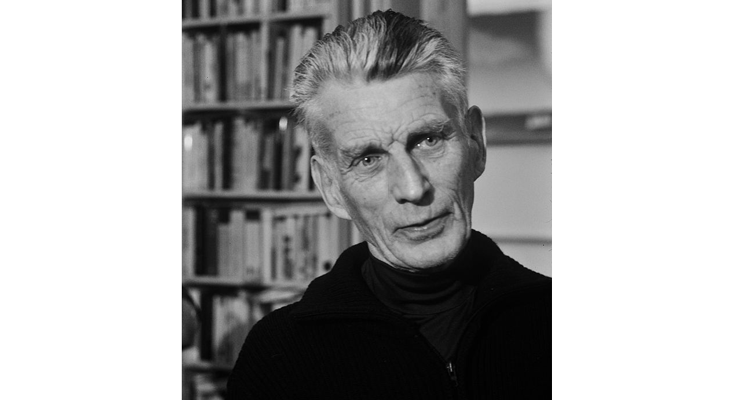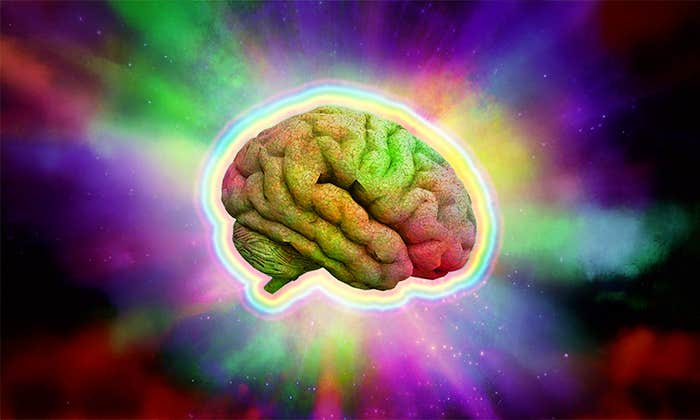In Samuel Beckett’s novel, The Unnamable, the anonymous narrator laments, “I’m all these words, all these strangers, this dust of words, with no ground for their setting, no sky for their dispersing.”
For Beckett’s narrator, words have become unmoored from their meaning. They no longer refer to anything in the physical world. Ultimately, they fail to fully convey or contain the inner message that prompted them. It’s a deeply unsettling feeling I suspect we’ve all experienced. Words become disconnected from our emotions, insufficient for what we want to convey. They betray us at moments when we need them most.
This sharp sense of despair is an opening to exploring why we have words in the first place. Many psychological factors drive one to speak, and one of them is the need to tell our story. However, for some, the motivation to tell our story can outstrip our capacity to do so, no matter how adept we are at words.

How serious is the gap between experience and the words we have? Serious. The need to render experience for others is tied to a need for others to understand us, and when unfulfilled, leaves an emptiness that hollows out our sources of motivation. This thin ornamental layer of words and the vast underbelly of thought and feeling beneath, etched into our biology, falls short of what we long to express.
The limits of words, like so many other shortfalls inherent in our biology, are like elbows that cannot bend backward, or the invisibility of a microscopic world around us, or the needless fears we have of others. Striking out against biological limits, with the only tools we have—human inventiveness—always carries unexpected consequences, and words as a biological limitation require a context from which to navigate the boundary between our words and their meaning.
In the history of brain evolution, words are a recent addition to the neurobiological repertoire. Like a non-native species, words have invaded the human brain and ascended to dominance as a tool to render experience.
Long before words, the kingdoms of life had mechanisms of communication. They had pheromones or chemical signals from bacteria that alerted the colony about nutrient conditions in the environment. No life form survives as a single individual; they are always multitudes, replicating within an ecosystem that has necessarily evolved communication systems as a critical adaptive tool. Clearly communication does not need words.
When adapted for survival, chemical communication must be precise, unambiguous, and stripped of nuance, and it must precisely render the intentions of the sender. When paired with the precision of chemical signals, words seem a paltry addition—they lack precision, are loaded with intentional or unintentional ambiguity and double entendre—far from what seems needed for survival. Except we apparently do need them. Organisms do not expend precious resources for functions without survival value and words would be an expensive adornment for the brain.
This sharp despair is an opening to exploring why we have words in the first place.
So what is the survival value of words? Vocalizations all through the animal kingdom project into a limited acoustic space, vibrate through the air to enclose within their boundaries all those capable of hearing the frequencies of these public announcements. Among hominins, the ability to provide detailed information about food sources and threats must have been advantageous. Beyond their information value, words assumed a phatic function, the empty pleasantries that establish social relationships and let us pose questions like, “How are you?” for which we do not expect answers.
While other primates accomplish this function perfectly well in the absence of words by grooming, words can perform “grooming” at a distance to avoid uncomfortable proximity. Words can refine social relationships with fine grain detail.
Establishing social relationships requires more than pleasantries and forms of address. Words allowed us to tell our stories to each other as a means of eliciting empathy and building trust. Or, reversing the arrow of time, the desire to render our experience gave us words. The evolutionary sequence of biological adaptations is not always knowable.
In any case, social networks, strengthened by the bonds of empathy, probably confer a collective advantage. Once endowed with words, we had the capacity to elicit empathy, which was motivation enough to use them for telling our story.
But motivation to speak can be dissociated from the capacity to speak. The drive to express ourselves can be joined with the sense that we cannot quite express ourselves fully, that language is inherently the limiting factor. Why should that be?
Via a complex circuitry, the brain delivers motivation to the body as a motor command to execute its will. One view is the brain is busy making predictions about the world such as what we will see when we turn the corner. If we are surprised by not seeing what we expected, then we are motivated to turn around and meet our expectations in some other direction or explore further. A failure to match the world with our expectation delivers a surprise and motivates the motor system. Speech is a motor system and attaching words to explain the world is a way to align pre-verbal perception or experience with an expected state.
Our closest living relatives—the old-world monkeys—route trillions of electrical messages through their gray and white matter and manage to fill their large brains with neural activity, while remaining devoid of words. Their grunts, barks, screams, and hoots and accompanying range of facial expressions convey messages including nuance, even some rudimentary elements of language. It’s difficult to know what they may be experiencing. Do their perceptions raise conflicts, questions, doubts, and anxieties that require communication tools beyond their capacity? Whatever the mental states of non-human primates, at some point words usurped a wordless consciousness.
Reduced to their elementary waveforms, words are complex vibrations generated by rapid movements of mouth parts, shaped according to learned patterns to convey meaning. The synchronization of vocalization muscles with millisecond timing and the neural firing patterns in the brain that generate the muscle movements are the physical embodiment of an abstraction called meaning.
The emitted sounds represent a thought or a feeling that motivated them. How can a vocalization in the form of a complex sound package, let’s say a signifier, which can be precisely described as a set of waveforms, serve as a representation of a thought?
Can we track thought instantiated as brain pulses, and recorded as complex waveforms, to its representation in the form of words? The neuroscientist probes this space from one direction as material changes in the brain—something one can see and measure in the dense underbrush of synapses, and makes the transformation to the abstract through models and equations. The writer pushes from the opposite direction, from an intangible mental state. From this perspective, the rigorously depersonalized, unallusive language of science feels like a hostile interface with the allusive, richly personalized language of literature. Beckett says it best: “I’m in the middle. I’m the partition. I’ve two surfaces and no thickness. Perhaps that’s what I feel, myself vibrating. I’m the tympanum. On the one hand the mind, on the other the word. I don’t belong to either.”
Packaging of a thought into an utterance necessarily assigns meaning, attributes a signifier to the signified. Meaning, undergirded by words, transmutes a large body of phonetic constructs in the form of some generally agreed upon practical significance. But much remains indeterminate, left dangling at the blurry boundaries of multiple meanings. The system of signifier and signified has multiple points of mismatch that create the uneasy sense of words as inadequate. Did the meaning assigned to the words of the sender match the meaning that the sender wanted to convey—did I say it right?—and were those words understood by the receiver according to the intentions of the sender? Words often imprecisely fit the shape of the desire for meaning that motivated them. And beyond the mismatch lies a vast realm of human feeling and perception and experience that falls entirely outside the power of language to capture.
A great deal of brain tissue is preoccupied with words. The specific mapping of a vocabulary onto brain activity, albeit plastic and dynamic, narrows the gap between mind and brain. Brain imaging allows us to watch the brain as the sounds of words assume meaning for the receiver. Whereas non-word sounds show discrete and limited activation patterns, word representations appear as intricate patterns tiled over large regions of the brain. Metaphors are understood by activating regions of the brain that correspond to sensory functions. For example, the phrase “she had a rough week” activates touch areas of the brain, and the phrase “grasp a concept” activates hand muscle regions related to an intentional action. As words spread over brain regions, they generate abstraction from more specific controllers of brain function, such as tactile regions for the word “rough” and motor regions for the word, “grasp.”
The circuitry of word meaning functions in flux with our internal bodily state. The pattern elicited by the word apple depends on whether we feel hungry or sated. The internal states of speaker and listener may differ and words can miss their mark as they cross the boundary into the mind. The tuning of word meaning, the many dials implanted in both sender and receiver, is where we face the opacity of mind, the impenetrability of subjectivity because the internal state is not made of objects or anything tangible, but of moods, of anxiety and joy, of awe and disgust, all without discrete metrics to objectify. More succinctly David Foster Wallace said, “How odd I can have all this inside me and to you it’s just words.”
Words allowed us to tell our stories to each other to elicit empathy and building trust.
As an imprecise abstraction of the internal state that cannot readily express the musings of consciousness, words can feel like a lie. They are inherently mismatched with the complex layering of meaning, a word-mind duality. As Beckett’s narrator in The Unnamable says, “On the one hand the mind, on the other the word. I don’t belong to either.”
Words are imperfect vehicles for thought, incapable of completely encompassing the nonlinear leaps through the brain. Stilling thought requires the tectonic concentration of a yogi to hold onto a mantra without intrusion. As one ascends the motor system from the simple reflexes of the spinal cord to the cerebral cortex, motor activity at the highest level of brain function becomes thought. In fact, when the motor system slows and the initiation of an action is difficult, as occurs in Parkinson’ disease, patients also suffer from bradyphrenia or slow thinking.
Once the brain develops, linguistic rules superimpose an abstract structure on communication. But in young children, words are incompletely bound by their syntactical context. With crib talk, young children engage in monologues that may be shaping the social function of language, and precise meaning is irrelevant. It’s similar to practicing scales on a musical instrument. With development, fitting words into the constraints of grammar transforms thought from something amorphous into a socially agreed upon conduit for communication with others.
Novel concepts must conform to the constraint-specifics based upon a deeply ingrained grammar that knits words together via syntax to create concepts. From nouns come categories. Some are predetermined, built into the anatomy and functional circuitry of the brain, such as face encoding, which is physiologically wired to identify specific faces. Word categories can be localized by fMRI—some brain regions respond more to words than non-words, or specifically represent concrete versus abstract words, action verbs, social narratives, or semantic areas honed for living things, tools, food, or shelter. All of these categories have overlapping blurry edges. As experience mounts, the particulars of each category get filled in and do so in a culturally modulated manner. By sweeping up cumulative experience from the surroundings, as a means to fill in the brain’s category bins and parsing the world into increasingly narrow categories, learned and operated upon by the brain, each person comes into possession of their own particulars, an identity.
The narrator probes an abstract place where silence and meaning co-exist.
FMRI activation patterns, which constitute brain circuitry, encode abstract semantic concepts signified by words. How many patterns are there? How frequently do we draw upon the same patterns for different perceptions and thereby blur differences or merge concepts? Can we predict brain activation patterns from specific words or predict from a brain activation pattern the associated thought? Not very accurately. The complexity of the environment far supersedes the complexity of the brain. Therefore, the brain is a data-reduction machine and what the brain can encode places a boundary upon human thought.
When narrowing the encoding capacity of the brain to words, one can compile them in terms of their usage, which approximates a statistical distribution called Zipf’s law. Among the utterances of natural language, the frequency of any word is inversely proportional to its rank in the frequency table. Accordingly, the most frequent words will occur about twice as often as the second most frequent words, and three times as often as the third most frequent words, and so on down the ranking. Ordered in this manner, only 135 vocabulary items are needed to account for half of English language usage in a sampling of texts with approximately 1 million words. This type of distribution with a very high frequency of common words and a long tail of low frequency words skews expression to a small proportion of the semantic repertoire. Representations with high frequency usage can facilitate communication and rarely used representations serve as a creative reservoir for expression.
Unlike nouns, pronouns present a problem of identity. The brain adopts a pronoun to encode agency, to assign responsibility for the consequences of an action. Pronouns can sharpen person distinctions or blur them. As anaphoric references, they lose focus with distance from their subject and become weightless, leaving the information-hungry brain spinning like the Mac color wheel. Turning to Beckett in The Unnamable, he faults the pronouns: “Someone says you. It’s the fault of the pronouns. There’s no name for me. No pronoun for me. All the trouble comes from that. That. It’s a kind of pronoun too.” The third and first person have an indistinct boundary in the brain. Paradoxically, the self and the other are encoded by the same neurons. The third person is a brain artifice that sets up an apposition figure, a seemingly outside voice within us, in some respects like the voice heard by the schizophrenic.
Nouns are limited by their categories (but capable of expanding through metaphor), pronouns create ambiguous identities, and verbs force an action within a temporal framework. Verbs are the motor system of language. As thoughts jump through time and memories, often unbidden, all of this motion relies on verbs to make the connections. All languages struggle with verbs, sometimes emphasizing fine gradations in time, while others require a statement of location embedded in the action. Encoding time taps into what is possibly the most core function of the brain—predicting the future. Predictions draw upon the past, which is called learning. Because multiple clocks, not just chronological time, mark change, packing a myriad of time scales into language, precise communication sometimes comes up short.
The mental state that corresponds to activation of the default mode network may be a glimpse of an interior consciousness detached from words. This network is a set of brain regions, located toward the back of the brain, that synchronize and in so doing disengage the brain from the external world akin to daydreaming or mind wandering.
“Default” describes the tendency for the brain to enter this state. Once disengaged from a task, from rationale episodic sequences with an inherent grammar, even momentarily, the default system is activated. Once we engage more deeply in the logical framework of a storyline, the brain shifts back from the default mode to activate a new pattern devoted to analysis and the logical framework of a storyline. The default mode, independent and non-linguistic, blinks off and language areas light up in a complex circuitry related to articulation, grammar, and semantics.
While the stories we tell rely on words, our collective stories, the stuff of myths and legends, fables and beliefs, reside, in part, within the default network. They arise from brooding about the night sky or mentally wandering through a nondescript expanse of partial sensations about a lost loved one. Within a community, these notions can gel into universal creation myths. The default network can synchronize among multiple individuals when watching a movie together or listening to a story together as we contemplate, absorb, and assimilate the characters and their actions.
These stories cannot be silenced. The nature of the default mode network connects human minds within a shared neurological territory. Drawing inspiration, the narrator in Beckett’s The Unnamable probes an abstract place where silence and meaning co-exist, where meaning is wordless and the effort to get there is relentless, and concludes: “You must go on. I can’t go on. I’ll go on.”
Kenneth S. Kosik is a neuroscientist whose work in Colombia on familial Alzheimer’s disease has appeared in The New York Times, BBC, CNN, PBS and 60 Minutes. His University of California Santa Barbara Arts and Humanities commencement address was archived at the Graduation Wisdom Best Commencement Speeches website.
Lead image: Brian A. Jackson / Shutterstock


























